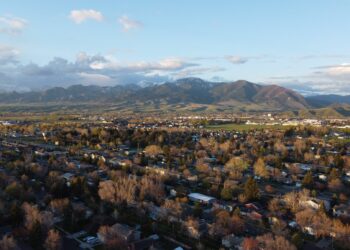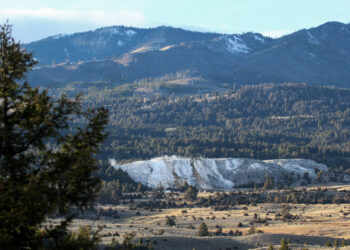By Darrell Ehrlick DAILY MONTANAN
About the only thing that can be said for certain about Sammy Williams is that he died in Manhattan, Montana, on Dec. 10, 1908.
Even how Williams died, his name and the rest of his life’s story are conflicting, murky or uncertain.
What can be said beyond the date of Sammy’s death is that the local undertaker, George R. Safely, was shocked to learn as he prepared the affable, longtime community member for burial that Sammy had the anatomy of a woman despite being known to everyone as a man.
Hardly knowing what to do, the members of the community, many who had been helped by Sammy’s famous charity, chipped in for a headstone that still sits in Meadowview Cemetery, south of Manhattan:
“A female whose real name is unknown but who has been for many years known as Sammy Williams. Died Dec. 10, 1908. Age about 68 yrs.”
Though no one can say anything about Williams’ reasons for arriving in Montana (although escape seems the most plausible), we know that he came to Montana, was accepted and loved, remembered for doing what any wild and wooly cook would do when arriving in Gallatin Valley: HE was known for loving to dance with the ladies, enjoying a stiff drink without ever getting drunk, and for being a great cook.
When Sammy died, there was an outpouring of grief from the men who worked the Heeb Ranch in Manhattan. Williams was known for caring for those who were sick, and some reported that at their most destitute moments, they would find $5 or $10 in their pocket, the quiet charity of Sammy.
And he also voted.
Charlotte Mills, the former Clerk and Recorder of Gallatin County, works as a part-time volunteer at the Gallatin Historical Museum and has helped Research Director Rachel Phillips dig for clues about Williams’ past.
In most elections, Phillips said, women were not allowed to vote, except for certain races, like school boards. In Montana, women secured the right to vote in 1914, ahead of the franchise going nationwide in 1920.
However, polling books show that Sammy voted at least three times in elections in Gallatin County before 1900. And he also had land – 320 acres, which he held at the time of his death. As county property records show, his estate was auctioned off and in a handwritten note, it said the land belonged to “Sammy H. Williams, a female.”
What the “H” stood for is not recorded, but Mills guesses it might stand for “Heeb” – the ranch for which he worked as a cook.
“That seems plausible,” Mills said.
But it’s his first and last name that seem so intentional – for the time period, “Sam” and “Williams” were both common – a lot more so than Ingebjorge Amundsdatter Wekans Viko.
That was name given to Sammy in Norway, likely in 1833.
However, Sammy’s story is really one told in two different halves.
The Wekans immigrated to America, settling in Allamakee County in Iowa, sometime in the middle of the nineteenth Century, and Ingebjorge came to the country with her childhood friend and fiancé, Sven Norem. But Norem’s family broke off the engagement, even as Ingebjorge was sewing her wedding clothes.
According to historical documents and newspaper accounts after Sammy’s death as the community tried to figure out Sammy’s past, Norem’s family opposed the marriage because the Wekan family status was too low.
At that point, Ingebjorge disappears from the historical record.
However, in the late 1850s, census records in Eau Claire, Wisconsin, show a Billy Williams, who arrived to work as a camp cook for the area’s thriving timber industry.
Williams is recorded as a “small, delicate-looking man” with black hair, a feminine voice and a slightly hunched back.
“Billy frequently went out with the lumberjacks where never hesitated to dance with the girls and spend his money. While he loved to drink and have a good time with his buddies, he was always careful never to become intoxicated,” wrote Phillips in an article for Bozeman magazine in March 2017. “Word quickly spread about Billy’s talent as a cook, and nearby logging camps hired him without delay.”
As a cook for nearly 30 years, he acquired a lot of money, which he used to purchase buildings and lots in Eau Claire, a rarity that caught the attention of town leaders.
“Billy Cook” was noted for speaking Norwegian, English and German fluently as well as picking up the languages of the Native Americans in the area.
“Even after leaving Eau Claire sometime in the 1880s, Billy Williams sent gifts of money back to his friends who still resided there,” Phillips’ article said. “The sick were never neglected when Billy was around – he made it a point to visit them and often stayed to nurse them through the night.”
However, trouble came to Wisconsin when a family moved from not-so-distant Iowa to Eau Claire and noticed Billy’s remarkable resemblance to the Wekan family.
Word got back to Iowa and one of the Wekan brothers was sent to Eau Claire to “persuade ‘Billy’ to return home.”
Billy made one last trip from Eau Claire back to Iowa, dressed as a tramp to apparently get one final look at his parents, and his former fiancé and his wife.
From there, Billy went farther west, working in North Dakota for several years before a Sammy landed in Manhattan.
It was there that Henry Heeb, a horse and cattle rancher, was in need of a ranch cook to replace his former employee who was getting older and wanted to return to his homeland of China.
Williams’ motives, his reasons, and even his backstory are vexingly elusive and simultaneously alluring, leading historians to think as much about what isn’t known as what is.
“She wanted to disappear,” Mills said, believing that was the most plausible reason for the transformation.
For 18 years, Sammy cooked and worked for different ranch outfits, Phillips records, including the Heeb Ranch, the Meadowbrook Ranch, the Number I Ranch and the Manhattan Company.
“He chewed tobacco and slept in the bunkhouse with the hired hands. One source claims he was the first to get up in the morning and last to climb up to bed at night, changing his clothes in the dark while others slept,” Phillips said.
The mystery of the former identity of Williams was only learned after his death when a local Gallatin County jeweler, C.J. O’Dell, believed that he had seen Sammy years before in Eau Claire. The Eau Claire chief of police was later able to fill in the details, recalling that Billy had disappeared shortly after his connection to the Wekan family was discovered.
“I think lots more things like this happened and some are known, and others happened because of what we know about the time period: It was a low population, and it took awhile for law and government to be established, and so to have this flexibility to be who you wanted to be was not uncommon,” Phillips said to the Daily Montanan. “I haven’t come across many stories like it. But because it’s unique, it could lead to new information to other people in similar places and owned property.
“But it’s important to note he lived a different life than many others, but from all accounts it was fulfilling and he died surrounded by friends.”













